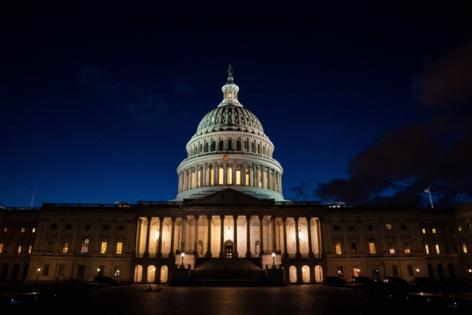Lots of talk but no deal as shutdown heads for the record books
Published in News & Features
The partial government shutdown is on track to become the longest in history as the Senate headed home for the weekend Thursday with no funding deal in sight.
The lack of action on a stopgap spending measure means the 30-day-old shutdown will continue at least into next week. The record was set in President Donald Trump’s first term, when a partial shutdown lasted 35 days, from December 2018 to January 2019, in a fight over funding for a southern border wall.
Senate Majority Leader John Thune, R-S.D., told reporters Thursday that he expects bipartisan talks focused on breaking the logjam to continue into the weekend. But there was still much uncertainty in the Senate as to what kind of off-ramp could earn sufficient support, despite members of both parties reporting an uptick in talks this week.
Rank-and-file members have largely reported progress in talks aimed at moving appropriations bills for fiscal 2026 once the government reopens.
Senate Democrats have been running a “hotline” on their side of the aisle to gauge support for a tranche of annual funding legislation approved by the Senate Appropriations Committee that could be packaged together — the Defense, Labor-HHS-Education, Transportation-HUD and Commerce-Justice-Science appropriations bills.
Senators have also pushed to begin a bicameral conference for the three funding bills that made it across the floor earlier this year: the Agriculture, Legislative Branch and Military Construction-VA bills.
But lawmakers still have a list of thorny issues to work out across both batches of spending bills, including matters like hemp regulations, funding levels for the legislative branch, and relocation of the FBI headquarters.
When asked about the future of the ongoing appropriations talks, Senate Appropriations Chair Susan Collins, R-Maine, said Thursday that “a lot of the next steps are being taken right now,” as intraparty and bipartisan discussions on funding have seen a new jolt of energy this week.
“It’s more of trying to build trust with each other, that we genuinely do want to commit to solving some of these problems, solving these problems once the shutdown ends and we quit holding the public hostage,” Sen. John Boozman, R-Ark., a senior appropriator, said of some of the discussions this week.
The pain inflicted by the shutdown will become sharply more acute over the weekend, when funding for food stamps is set to run dry and open enrollment begins for health insurance plans sold on the exchanges created under the Obama administration’s health care law.
As a condition for reopening government, Democrats have been insisting on extending the health insurance subsidies for those plans that are set to expire at year’s end and trigger dramatic increases in premiums. Republicans have said they’re willing to discuss those subsidies, but only after the government reopens.
Sen. Chris Coons of Delaware, a senior Democratic appropriator, said Thursday that getting the full-year Agriculture funding bill through Congress would be “pretty attractive” to prevent disruptions in food stamp benefits next month. But he also said he wants to “see a path forward” on extending the health subsidies.
Health insurance pressure point
Thune would likely need five more Democratic votes to clear the House-passed continuing resolution that would end the shutdown. He reiterated Thursday that he’s open to giving Democrats a vote on legislation extending the health credits as part of an agreement to reopen the government.
“They want a date certain for a vote, to have that vote, then we can do that,” he said. He also signaled openness to bringing up a potential bipartisan bill on a revamped health package.
But Democratic leaders have opposed the idea of settling for a simple vote on health subsidies that would appear almost certain to be defeated along party lines. Less clear is whether enough centrist Democrats would decide to break ranks with party leaders as the pain of the shutdown intensifies.
“I think that’s a judgment call the caucus is going to have to make,” Coons said when asked about the idea of a vote on extending the subsidies. “If the House of Representatives refuses to come back, and the president stays disengaged, like us having a vote in the Senate doesn’t do anything in the House.” The House has been in recess, except for pro forma sessions, since it passed the continuing resolution in mid-September.
Sen. Tim Kaine, D-Va., said this week that he wants “forward motion on health care,” but that he doesn’t “need every I dotted and T crossed,” when asked if a health agreement is necessary for Democrats to vote to reopen the government.
As senators headed for the exits Thursday, those flying back to their home states were directly confronted by the escalating pain of the sprawling shutdown. Ronald Reagan Washington National Airport, the preferred airport of many lawmakers, was under a ground delay due to staffing issues, with an average 90-minute wait, according to the Federal Aviation Administration.
During the 35-day government shutdown in the first Trump administration, flight delays were a key pain point that led to the logjam break. And the list of people impacted by Thursday’s delays included Thune himself. He predicted that these delays are “going to intensify, increase and get worse.”
And he added: “That’s what happens when you have a government shutdown.”
The post Lots of talk but no deal as shutdown heads for the record books appeared first on Roll Call.
©2025 CQ-Roll Call, Inc., All Rights Reserved. Visit cqrollcall.com. Distributed by Tribune Content Agency, LLC.







Comments